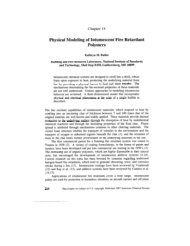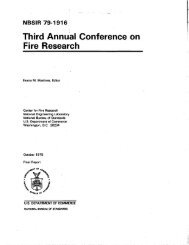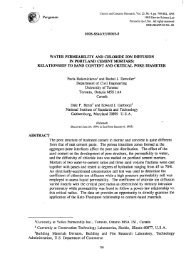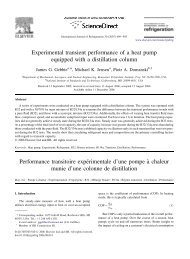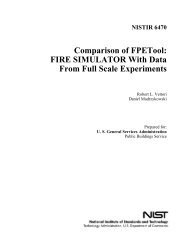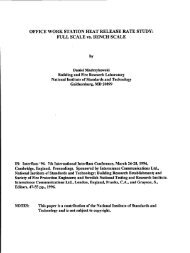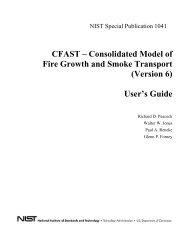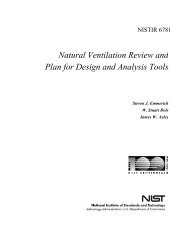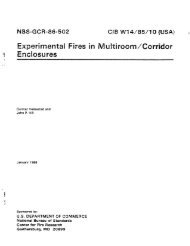Study of Technology for Detecting Pre-Ignition Conditions of ... - NIST
Study of Technology for Detecting Pre-Ignition Conditions of ... - NIST
Study of Technology for Detecting Pre-Ignition Conditions of ... - NIST
You also want an ePaper? Increase the reach of your titles
YUMPU automatically turns print PDFs into web optimized ePapers that Google loves.
msc-HG95-1145<br />
because a candidate signature must exist <strong>for</strong> each type <strong>of</strong> food if it is to have potential as input<br />
to a universal pre-cooking-fire sensor. Diverse range types were <strong>of</strong> interest because <strong>of</strong> potential<br />
variation in i~ition modes due to a proximate flame on the gas range, although in these<br />
experiments, the ranges functioned primarily as sources <strong>of</strong> heat. The use <strong>of</strong> the different ranges<br />
selected was expected to have some effect on the time lag <strong>of</strong> the behaviors <strong>of</strong> the recorded<br />
variables because <strong>of</strong> the varied levels <strong>of</strong> heat flux output associated with each range. The rangehood<br />
status was <strong>of</strong> interest <strong>for</strong> two reasons. l?irs~ the flow caused by an active range hood might<br />
obscure the signature(s) <strong>of</strong> interest preceding ignition. Second, the different flow patterns might<br />
alter entrainment <strong>of</strong> air wh~ch could effect the mechmism and location <strong>of</strong> ignition and thus the<br />
preceding set <strong>of</strong> signatures as well.<br />
The selected foods and ranges were chosen because they were typically used <strong>for</strong> cooking<br />
in households and were representative <strong>of</strong> cooking fire scenarios that have actually been reported.<br />
More uncommon range models, food types, and styles <strong>of</strong> cooking could have been tested, but<br />
their results are less relevant at this stage.<br />
2.1.1 Facility Constm~ion<br />
A small, stand-alone laboratory was built in Building 205, the Large-Fire Facility, at <strong>NIST</strong><br />
to acmmmodate these experiments. A schematic <strong>of</strong> the room is shown in Figure 1. The interior<br />
dimensions <strong>of</strong> the room are as follows: 3.66 m (12 ft) width, 2.44 m (8 ft) depth, and 2.44 m<br />
@ ft) height. The room was outfitted with double-tide doors, 163 cm (64 in) wide by 207 cm<br />
(81 in) high, and fluorescent lighting. Access holes were made <strong>for</strong> external supplies <strong>of</strong> electrical<br />
power and natural gas. The stmcture consists <strong>of</strong> 2.44 m (8 ft) lengths <strong>of</strong> 8.9 cm (3.5 in) by<br />
3.2 cm (1.3 in) galvanized steel studding on the outside with 40.6 cm (16 in) centers supporting<br />
1.3 cm (0.5 in) thick gypsum drywall with the interior painted white. A set <strong>of</strong> white wooden<br />
cabinets with overhead cupboards and a countertop with cupboards below were installed. A space<br />
in the center was reserved <strong>for</strong> range installation.<br />
A range hood (described in Section 2.1.2) was installed above the range location. A<br />
25.5 cm (10 in) wide by 8.9 cm (3.5 in) high rectangular hood duct passes through the wall<br />
directly behind the range hood to an elbow that transitions to a 15 cm (6 in) diameter round duct.<br />
The round duct is vertical <strong>for</strong> about 0.6 m (2 ft) where it connects to an elbow, traverses about<br />
1.8 m (6 ft) horizontally to another elbow where the end is directed upwards and is positioned<br />
approximately 10 cm (4 in) below a large 41 cm (16 in) diameter duct which connects to tie<br />
draft hood afterbmer system.<br />
A box hood, 188 cm (74 in) wide by 58 cm (23 in) deep by 91 cm (36 in) high, was<br />
constructed over the doorway to capture most <strong>of</strong> the smoke produced by the experiments. The<br />
hood was made <strong>of</strong> 9 mm (3/8 in) thick plywood. From 46 cm (18 in) above the bottom <strong>of</strong> the<br />
hood to 67 cm (26.5 in), the width <strong>of</strong> the box tapers from 188 cm (74 in) to 30 cm (12 in). The -top<br />
24 cm (9.5 in) <strong>of</strong> the hood is 30 cm (12 in) wide by 58 cm (23 in) deep. The hood is<br />
connected at the side <strong>of</strong> the top section to a 20 cm @ in) diameter, 4.3 m (14 R) long duct which<br />
leads to a fan which pulls the exhaust into the duct <strong>of</strong> the afterburner system.<br />
Electrical power was provided from two sources. AH <strong>of</strong> the instimentition was supplied -<br />
120 V electricity from a portable electric sub-panel box with a 60 amp rating which split 240 V<br />
2<br />
.-



